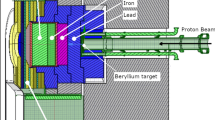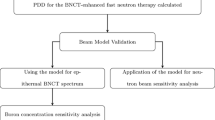Abstract
A study was conducted to investigate a photoneutron spectrum based on a 25 MeV electron linac for treatment of deep-seated brain tumors in the context of boron neutron capture therapy (BNCT). Based on a series of Mont Carlo N-Particle simulations, tungsten and uranium with optimized geometry were selected as the most appropriate converters for (e,γ) and (γ,n) reactions, respectively. The final optimized photoneutron source yield was 5.78 × 1013 n/s/mA, which is a high value for these kinds of sources. A beam shaping assembly (BSA) for the proposed neutron source containing optimal moderators, filter, reflector, and collimator was simulated. Results showed that using this BSA enables us to meet International atomic energy agency recommended figures of merit at the BSA beam port. Also, the calculated in-phantom figures of merit and dose evaluation results via a simulated head phantom confirmed that the designed neutron source and its related BSA configuration can potentially treat deep-seated brain tumors in BNCT framework. In the present study, some in-phantom figures of merit such as advantage depth, advantage depth dose rate, advantage ratio, and treatment time are 7.6 cm, 0.7 Gy/min, 4.2, and 17.8 min, respectively.








Similar content being viewed by others
References
Kageji T, Mizobuchi Y, Nagahiro S, Nakagawa Y, Kumada H (2011) Clinical results of boron neutron capture therapy (BNCT) for glioblastoma. Appl Radiat Isot 69:1823–1825
Yamamoto T, Matsumura A, Nakai K, Shibata Y, Endo K, Sakurai F, Kishi T, Kumada H, Yamamoto K, Torii Y (2008) Current clinical results of the Tsukuba BNCT trial. Appl Radiat Isot 61:1089–1093
Rao M, Trivillin VA, Heber EM, de L Cantarelli M, Itoiz ME, Nigg DW, Jimenez Rebagliati R, Batistoni D, Schwint AE (2004) BNCT of 3 cases of spontaneous head and neck cancer in feline patients. Appl Radiat Isot 61:947–952
Hughes AM, Heber EM, Pozzi E, Nigg DW, Calzetta O, Blaumann H, Longhino J, Nievas SI, Aromando RF, Itoiz ME, Trivillin VA, Schwint AE (2009) Boron neutron capture therapy (BNCT) inhibits tumor development from precancerous tissue: an experimental study that supports a potential new application of BNCT. Appl Radiat Isot 67(2009):S313–S317
Kato I, Ono K, Sakurai Y, Ohmae M, Maruhashi A, Imahori Y, Kirihata M, Nakazawa M, Yura Y (2004) Effectiveness of BNCT for recurrent head and neck malignancies. Appl Radiat Isot 61:1069–1073
Yamamoto T, Nakai K, Matsumura A (2008) Boron neutron capture therapy for glioblastoma. Cancer Lett 262:143–152
Zamenhof RG, Murray BW, Brownell GL, Wellum GR, Toplin EI (1975) Boron neutron capture therapy for the treatment of cerebral gliomas I: theoretical evaluation of the efficacy of various neutron beams. Med Phys 2:47–60
Bisceglie E, Colangelo P, Colonna N, Santorelli P, Variale V (2000) On the optimal energy of epithermal neutron beams for BNCT. Phys Med Biol 45:49–58
Cerullo N, Esposito J, Leung KN, Custodero S (2002) An irradiation facility for boron neutron capture therapy application based on a radio frequency driven D–T neutron source and a new beam shaping assembly. Rev SciInstrum 73:3614–3618
Auterinen I, Seren T, Anttila K, Kosunen A, Savolainen S (2004) Measurement of free beam neutron spectra at eight BNCT facilities worldwide. Appl Radiat Isot 61:1021–1026
Palmer MR, Goorley JT, Kiger WS III, Busse PM, Riley KJ, Harling OK, Zamenhof RG (2002) Treatment planning and dosimetry for the Harvard-MIT phase I clinical trial of cranial neutron capture therapy. Int J Radiat Oncol Biol Phys 53:1361–1379
Giusti V, MunckafRosenschöld PM, Sköld K, Montagnini B, Capala J (2003) Monte Carlo model of the Studsvik BNCT clinical beam: description and validation. Med Phys 30:3107–3117
Kononov OE, Kononov VN, Bokhovko MV, Korobeynikov VV, Soloviev A, Sysoev AS, Gulidov IA, Chub WT, Nigg DW (2004) Optimization of an accelerator-based epithermal neutron source for neutron capture therapy. Appl Radiat Isot 61:1009–1013
Rasouli FS, Masoudi SF (2010) Design and optimization of a beam shaping assembly for BNCT based on D–T neutron generator and dose evaluation using a simulated head phantom. Appl Radiat Isot 70:2755–2762
Yue G, Chen J, Song R (1997) Study of boron neutron capture therapy used neutron source with protons bombarding a thick 9Be target. Med Phys 24:851–855
Verbeke JM, Vujic JL, Leung KN (2000) Neutron beam optimization for boron neutron capture therapy using the D–D and D–T high energy neutron sources. Nucl Technol 129:257–278
Ghassoun J, Chkillou B, Jehouani A (2009) Spatial and spectral characteristics of a compact system neutron beam designed for BNCT facility. Appl Radiat Isot 67:560–564
Kim GN, Kovalchuk V, Lee YS, Skoy V, Cho MH, Ko IS, Namkung W, Lee DW, Kim HD, Ko SK, Park SH, Kim DS, Ro TI, Min YG (2002) Measurement of photoneutron spectrum at Pohang Neutron Facility. Nucl Instrum Methods Phys Res A 485:458–467
Quintieri L, Bedogni R, Buonomo B, De Giorgi M, Chiti M, Esposito A, Foggetta L, Gentile A, Mazzitelli G, Valente P, Gomez-Ros JM, Festa G, Pietropaolo A, Reali E (2012) A photoneutron source at the DaΦne beam test facility of the INFN National Laboratories in Frascati: design and first experimental results. Phys Procedia 26:246–260
Fantidis JG, Bandekas DV, Vordos N (2013) The replacement of research reactors with a compact proton linac for neutron radiography. Radiat Phys Chem 86:74–78
Kiyanagi Y, Asano K, Arakawa A, Hiraga, Hiraga F, Kimura K, Kobayashi H, Kubota M, Kumada H, Matsumoto H, Matsumoto A, Sakae T, Saitoh K, Shibata T, Yoshioka M (2012) A project of boron neutron capture therapy system based on a proton linac neutron source. Phys Procedia 26:223–230
Ahmadi Ganjeh Z, Masoudi SF (2014) Neutron beam optimization based on 7Li(p,n) 7Be reaction for treatment of deep-seated brain tumors by BNCT. Chinese Phys C. (In Press)
Pazirandeh A, Torkamani A, Taheri A (2011) Design and simulation of a neutron source based on an electron linear accelerator for BNCT of skin melanoma. Appl Radiat Isot 69:749–755
Patila BJ, Chavanb ST, Petheb SN, Krishnanb R, Bhoraskara VN, Dholea SD (2012) Design of 6 MeV linear accelerator based pulsed thermal neutron source: FLUKA simulation and experiment. Appl Radiat Isot 70:149–155
Devan K, Meaze AKMMH, Kim G, Lee YS, Kang H, Cho MH, Ko IS, Namkung W, Van Do N, Khue PD, Thiep TD, Van Duan P (2006) Photo-neutrons produced at the Pohang neutron facility based on an electron linac. J Korean Phys Soc 49:89–96
Auditore L, Barna RC, De Pasquale D, Italiano A, Trifiro A, Trimarchi M (2005) Study of a 5 MeV electron linac based neutron source. Nucl Instrum Methods Phys Res B 229:137–143
Rahmani F, Shahriari M, Minoochehr A, Nedaie H (2011) Feasibility study on the use of uranium in photoneutron target and BSA optimization for linac based BNCT. Nucl Instrum Methods Phys Res A 641:136–140
Bevilacqua R, Giannini G, Calligaris F, Fontanarosa D, Longo F, Scian G, Totaro P, Vittor K, Vallazza E, Severgnini M, Vidimari R, Bartesaghi G, Conti V, Mascagna V, Perboni C, Prest M, Gambarini G, Gay S, Valente MA, Mozzanica A, Monti A, Ostinelli A, Azario L, Fidanzio A, Piermattei A, Borla O, Durisi E, Fasolo F, Nastasi U, Perosino E, Zanini A, Tommasino L (2007) PhoNeS: a novel approach to BNCT with conventional radiotherapy accelerators. Nucl Instrum Methods Phys Res A 572:231–232
Waters LS (2002) MCNPX User’s manual version 2.4.0. Los Alamos national laboratory report LA-CP-02-408
IAEA-TECDOC-1223, (2001) Current status of neutron capture, therapy International atomic energy agency
Kiger WS, Sakamoto S, Harling OK (1999) Neutronic design of a fission converter-based epithermal neutron beam for neutron capture therapy. Nucl Sci Eng 131:1–22
Chanana AD (1996) Boron neutron capture therapy of glioblastoma multiforme at the Brookhaven medical research reactor, a Phase I/II Study, FDA IND #43317, Protocol #4, Medical department, Brookhaven national Laboratory, Upton, New York 11973
Torabi F, Masoudi SF, Rahmani F (2013) Photoneutron production by a 25 MeV electron linac for BNCT application. Ann Nucl Energy 54:192–196
Rahmani F, Shahriari M (2010) Beam shaping assembly optimization of linac based BNCT and in-phantom depth dose distribution analysis of brain tumors for verification of a beam model. Ann Nucl Energy 38:404–409
Durisi E, Zanini A, Manfredotti C, Palamara F, Sarotto M, Visca L, Nastasi U (2007) Design of an epithermal column for BNCT based on D–D fusion neutron facility. Nucl Instrum Methods Phys Res A 574:363–369
Cerullo N, Esposito J, Daquino GG (2004) Spectrum shaping assessment of accelerator-based fusion neutron sources to be used in BNCT treatment. Nucl Instrum Methods Phys Res B 213:641–645
Bleuel DL, Donahue RJ, Ludewigt BA, Vujic J (1998) Designing accelerator-based epithermal neutron beams for boron neutron capture therapy. Med Phys 25:1725–1734
Sakamoto S, Kiger WS, Harling OK (1999) Sensitivity studies of beam directionality, beam size, and neutron spectrum for a fission converter-based epithermal neutron beam for boron neutron capture therapy. Med Phys 26:1979–1988
Coderre JA, Morris GM (1999) The radiation biology of boron neutron capture therapy. Radiat Res 151:1–18
Barth RF, Coderre JA, Vicente MG, Blue TE (2005) Boron neutron capture therapy of cancer: current status and future prospects. Clin Cancer Res 11:3987–4002
Herrera MS, Gonzalez SJ, Burlon AA, Minsky DM, Kreiner AJ (2011) Treatment planning capability assessment of a beam shaping assembly for accelerator-based BNCT. Appl Radiat Isot 69:1870–1873
Ye Sung-Joon (1999) Boron self-shielding effects on dose delivery of neutron capture therapy using epithermal beam and boronophenylalanine. Med Phys 26:2488–2493
Author information
Authors and Affiliations
Corresponding author
Rights and permissions
About this article
Cite this article
Torabi, F., Farhad Masoudi, S., Rahmani, F. et al. BSA optimization and dosimetric assessment for an electron linac based BNCT of deep‐seated brain tumors. J Radioanal Nucl Chem 300, 1167–1174 (2014). https://doi.org/10.1007/s10967-014-3087-0
Received:
Published:
Issue Date:
DOI: https://doi.org/10.1007/s10967-014-3087-0




